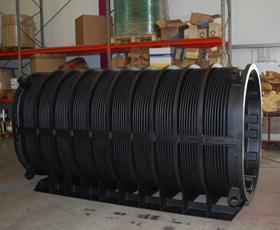
Bellows were used earlier to keep the fire burning while cooking but at present, they are widely applied for the same reason but in different industries. To name a few are engineering and mechanical, hydraulics, pneumatics, food, plastic, cement and tiles, electrical and electronics, chemical, scientific instrumentation, marble polishing, coal, and paint, grinding and manufacturing industries. A great amount of heat is required during the processing in such industries. Bellows are used here to increase the output of heat required for the process.
There are several manufacturers of bellows in the market today. Only the rich experienced manufacture bellows having the potential to reduce maintenance cost and increase the life of the machine. The bellows are manufactured out of various material and come in various shape and size. The leading manufacturers produce metal cladding bellows, PTFE bellows, rubber bellows, high-temperature fabric bellows, C Type bellows, round, hexagonal and octagonal bellows, square type bellows, etc. Bellows are manufactured in such shapes to meet the specific requirement of any particular industrial process. For example, the metal cladding bellows are used where there is no space for compression and continuous processing is going on whereas the rubber coated fabric bellows are used in those industries where the flow of water coolant is continuous.
Certain bellows are also designed to match with the specific pressure requirement such as the rubber expansion joint bellows. The split type bellow manufacturers have designed it so since assembly can’t be opened hence press buttons are provided. When the compression space available is zero and maximum expansion length is required for a machine then roller covers are used. A few high-temperature bellows manufacturer have gained a reputation in producing bellows that have the potential to withstand temperature up to 1200 to 1400.
One of the main advantages of using metal bellows seal is the removal of semi dynamic sliding elastomer from a conventional pusher type mechanical seal. The remaining static elastomer may operate in a suitable manner after, for example, swelling from chemical attack compared to the effect of the semi dynamic elastomer in a pusher seal. At relatively low temperatures, many elastomers suffer shrinkage or swell rates. Therefore, the primary applications of these bellows are to overcome the problems of a chemical attack on the elastomers.
One of the commonly misunderstood facts is that bellows can always be used on relatively high-temperature applications. The performance of the sealing of the bellows is largely dependent on the construction of materials.
Not all applications are suited for the bellow technology. These bellows are applied in food industries. However, these bellows are deemed disadvantageous as the convolutions create bugs traps, which are very difficult to clean thoroughly. In slurry applications, the convolutions of the bellows are applied to that point, where they are unable to move in an adequate manner.
Just like mechanical seal design, the seal is only as good as the environment it is used. One of the keys to the mechanical sealing is changing the seal. In some of the applications, this is not possible and that is why the right material selection of actual seal design and construction are of utmost important.


Leave a Reply